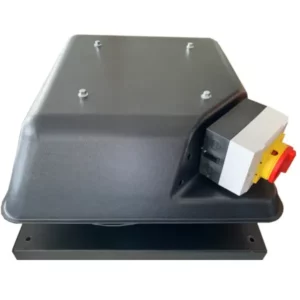In both residential and commercial buildings, proper ventilation is crucial for maintaining a comfortable and healthy indoor environment. One key component in ventilation systems is the axial roof exhaust fan. In this article, we will delve into the inner workings of axial roof exhaust fans, exploring how they operate to effectively remove stale air, control humidity levels, and enhance overall air quality.
I. Design and Configuration
- Axial Fan Blades:
Axial roof exhaust fans consist of a set of axial fan blades, typically made of lightweight and durable materials such as aluminum or plastic. These blades are designed in a propeller-like configuration, enabling them to move air in a straight path. - Motor and Drive Mechanism:
The fan blades are connected to a motor, usually located within the fan housing. The motor powers the rotation of the blades, generating airflow. The drive mechanism, such as belts or direct drive, transfers the motor’s rotational energy to the fan blades.
II. Air Extraction Process
- Air Intake:
Axial roof exhaust fans are installed on the roof of a building, typically in areas such as bathrooms, kitchens, or industrial spaces. They pull in air from the building interior through ductwork or openings, creating a pressure difference. - Airflow Generation:
As the motor rotates the fan blades, they create a low-pressure zone behind them. This low pressure causes the air to be drawn in and propelled forward. The axial design of the fan blades ensures that the airflow is directed vertically upwards, facilitating the extraction process. - Exhaust and Discharge:
The propelled air is forced out through the fan housing and discharged into the external environment. This expulsion of air removes unwanted odors, moisture, and pollutants from the building, promoting fresh and clean air circulation.
III. Benefits and Applications
- Effective Ventilation:
Axial roof exhaust fans play a vital role in maintaining proper ventilation in residential, commercial, and industrial settings. They remove stale air, smoke, and fumes, helping to improve indoor air quality and create a more comfortable living or working environment. - Temperature and Humidity Control:
By expelling hot air and excess humidity from the building, these fans assist in regulating temperature and moisture levels. This is particularly important in spaces such as kitchens, bathrooms, and manufacturing facilities, where heat and humidity can accumulate rapidly. - Odor and Contaminant Removal:
Axial roof exhaust fans are highly effective at removing unpleasant odors, airborne contaminants, and potentially harmful gases from the building. This is especially valuable in areas that generate strong odors or where hazardous substances are present.
Axial roof exhaust fans are essential components of ventilation systems, ensuring the efficient extraction of stale air, controlling humidity levels, and improving indoor air quality. Through their innovative design and reliable operation, these fans provide a robust solution for maintaining a healthy and comfortable environment in residential, commercial, and industrial buildings. By understanding how axial roof exhaust fans work, we can appreciate their significant impact on promoting fresh, clean, and well-ventilated spaces for occupants to thrive in.
How axial roof exhaust fan works ?
Here’s how the axial flow roof exhaust fan works:
- Atmospheric pressure difference: The operation of the axial flow roof exhaust fan depends on the atmospheric pressure difference. By creating a low pressure area in the room, the fan is able to attract and push air, thus enabling the exhaust process.
- Fan speed and power: The speed and power of the fan have an important effect on its exhaust capacity. Higher fan speeds produce more air flow, but they also consume more energy. Choosing the right fan speed and power is key to making trade-offs based on specific exhaust needs.
- Exhaust duct or vent: An axial flow roof exhaust fan is usually connected to an exhaust duct or vent. These pipes are responsible for directing the dirty air inside the house to the fans and discharging the discharged air from the roof to the outside. Ensure that the piping is properly designed and laid out to minimize drag and wind resistance, thereby improving fan exhaust efficiency.
- Control and automation functions: Some axial flow roof exhaust fans have control and automation functions so that they can be adjusted as needed. These features include adjustable wind speed, timers, humidity sensors, and more to automatically start, stop, or adjust the fan’s operating mode according to specific conditions and needs.
- Waterproof and weather resistant: Axial flow roof exhaust fans are usually waterproof and weather resistant to meet the challenges of outdoor environments. They are designed with special seals and enclosures to ensure reliable operation in all weather conditions and to prevent rain or contaminants from entering the inside of the fan.
- Maintenance and cleaning: In order to maintain the normal operation of the axial flow roof exhaust fan, regular maintenance and cleaning are necessary. This includes removing the buildup of dust, grease or debris and checking that the fan’s motor and transmission components are functioning properly.
Axial flow roof exhaust fans are a reliable and efficient exhaust solution that effectively eliminates dirty air, controls humidity, and improves indoor air quality. By understanding how they work and their key characteristics, you can better choose and use the axial flow roof exhaust fan that suits your needs and ensures a comfortable and healthy indoor environment.
